Japan Insulin Drugs And Delivery Devices Market Size
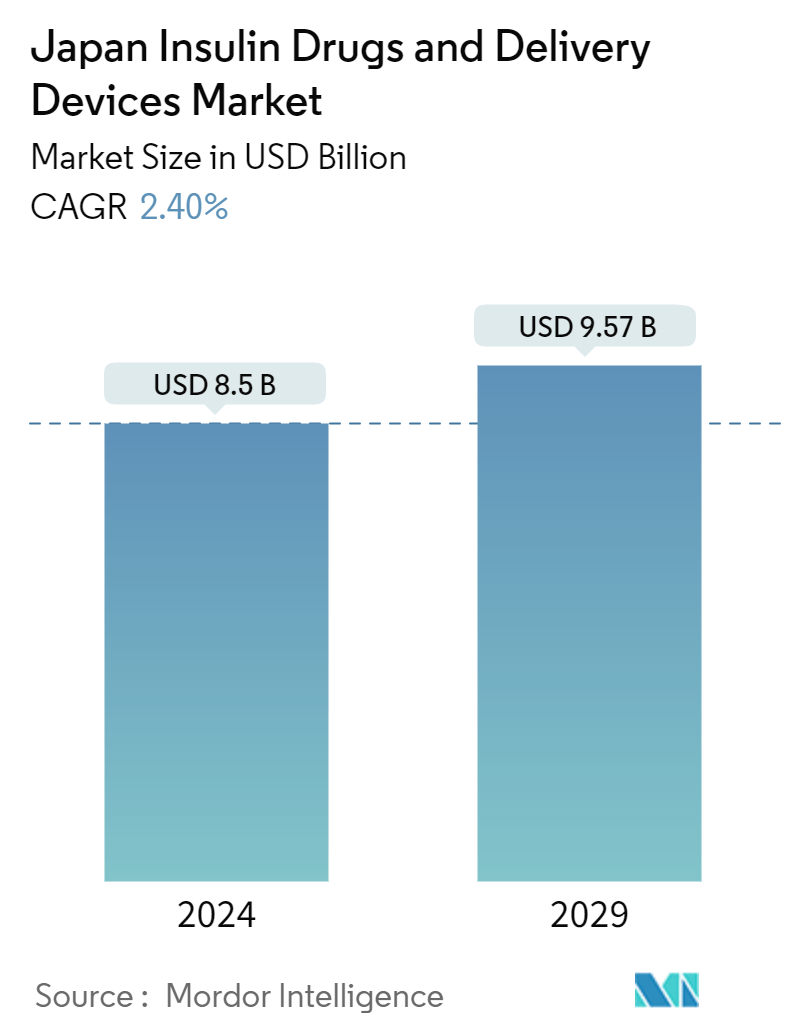
| Study Period | 2019 - 2029 |
| Base Year For Estimation | 2023 |
| Forecast Data Period | 2024 - 2029 |
| Market Size (2024) | USD 8.5 Billion |
| Market Size (2029) | USD 9.57 Billion |
| CAGR (2024 - 2029) | 2.40 % |
Major Players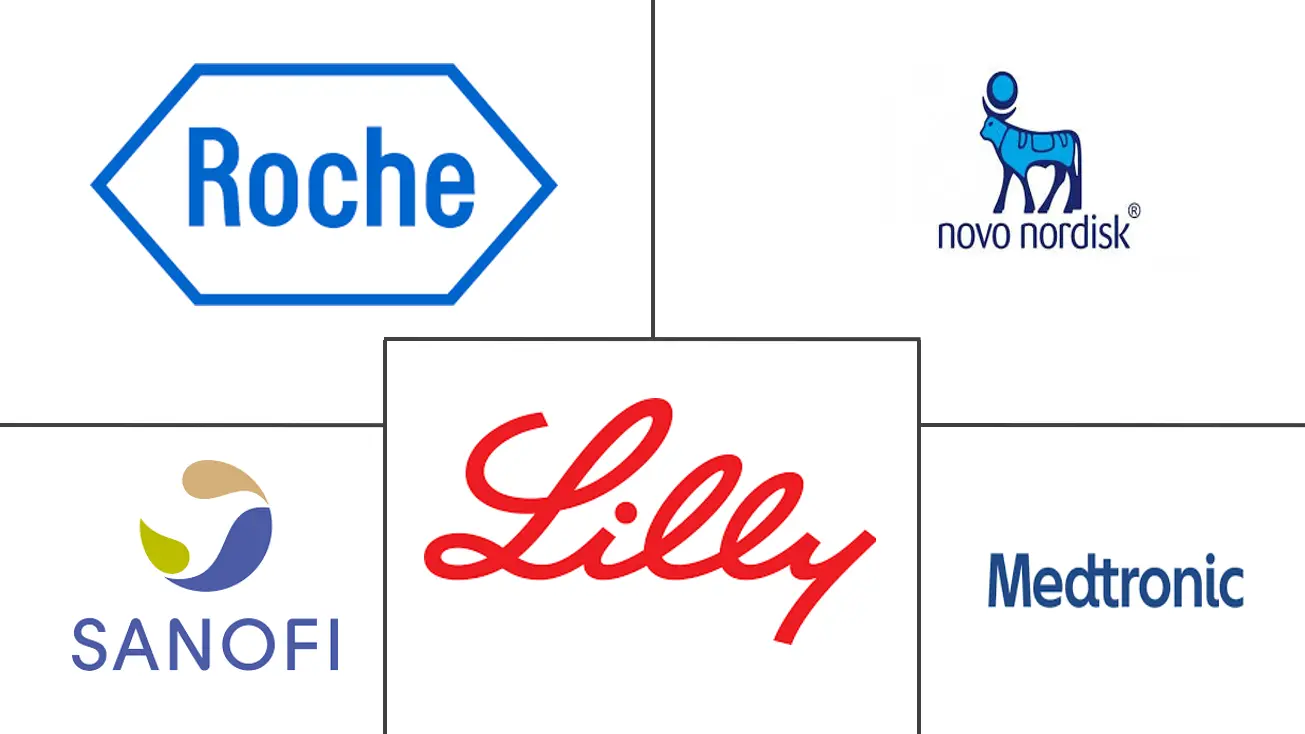
*Disclaimer: Major Players sorted in no particular order |
Japan Insulin Drugs And Delivery Devices Market Analysis
The Japan Insulin Drugs And Delivery Devices Market size is estimated at USD 8.5 billion in 2024, and is expected to reach USD 9.57 billion by 2029, growing at a CAGR of 2.40% during the forecast period (2024-2029).
In Japan, there has been a consistent increase in the number of individuals with diabetes who are using insulin medications and devices, aligning with the global trend of diabetes prevalence on the rise. The aging population and changes in lifestyle factors like diet and physical activity have contributed to a significant surge in diabetes cases, encompassing both type 1 and type 2 diabetes.
Type 1 diabetes, while less common than type 2 diabetes, affects a substantial portion of the population in Japan. These individuals depend on insulin medications to manage their condition, showing a preference for newer insulin formulations and delivery devices that offer enhanced convenience and accuracy in dosing. For instance, insulin pens have gained popularity among Japanese patients due to their user-friendly nature and discreetness, enabling more flexible insulin administration in various settings.
Moreover, the adoption of advanced insulin delivery devices such as insulin pumps and continuous glucose monitoring (CGM) systems is increasing in Japan. These technologies empower patients to have better control over their diabetes management by providing continuous insulin delivery and real-time glucose monitoring, ultimately aiding in optimizing blood sugar levels and reducing the risk of complications related to hypoglycemia and hyperglycemia.
Despite these advancements, challenges persist in ensuring equal access to insulin medications and devices for all individuals with diabetes in Japan. It is essential to address issues like financial barriers, healthcare infrastructure, and patient education to effectively manage the diabetes population and enhance outcomes in the country. Through ongoing efforts in research, healthcare policies, and public awareness, Japan is committed to advancing diabetes management and care for its population reliant on insulin medications and devices.
As a result of the aforementioned factors, the studied market is expected to grow during the analysis period.
Japan Insulin Drugs And Delivery Devices Market Trends
Growing Diabetes and Obesity Population in Japan
Diabetes cases are thought to be increasing in Japan due to an increase in the number of older adults, who are more vulnerable to disease, as well as an increase in obesity due to a lack of exercise and irregular eating habits. While an immune system malfunction causes Type 1 diabetes, Type 2 diabetes is associated with a sedentary lifestyle, leading to inherent insulin resistance. As a result, Type 1 diabetes can be classified as insulin-requiring, whereas Type 2 diabetes can be classified as insulin-dependent. Japan has one of the world's largest elderly populations, making it more vulnerable to the onset of type 2 diabetes.
Diabetes is becoming more common in Japan as the country's population ages. Insulin devices encompass a range of tools and technologies designed to deliver insulin effectively and conveniently to patients.
Insulin pens and syringes are commonly used for manual insulin injections, while insulin pumps deliver insulin continuously through a small catheter placed under the skin. CGM systems, on the other hand, continuously monitor glucose levels in the interstitial fluid, providing real-time data to help patients manage their diabetes more effectively. Overall, insulin drugs and devices play a crucial role in diabetes management, helping patients maintain optimal blood sugar control and minimize the risk of complications associated with the condition.
Because of the factors above, the market is expected to expand further.
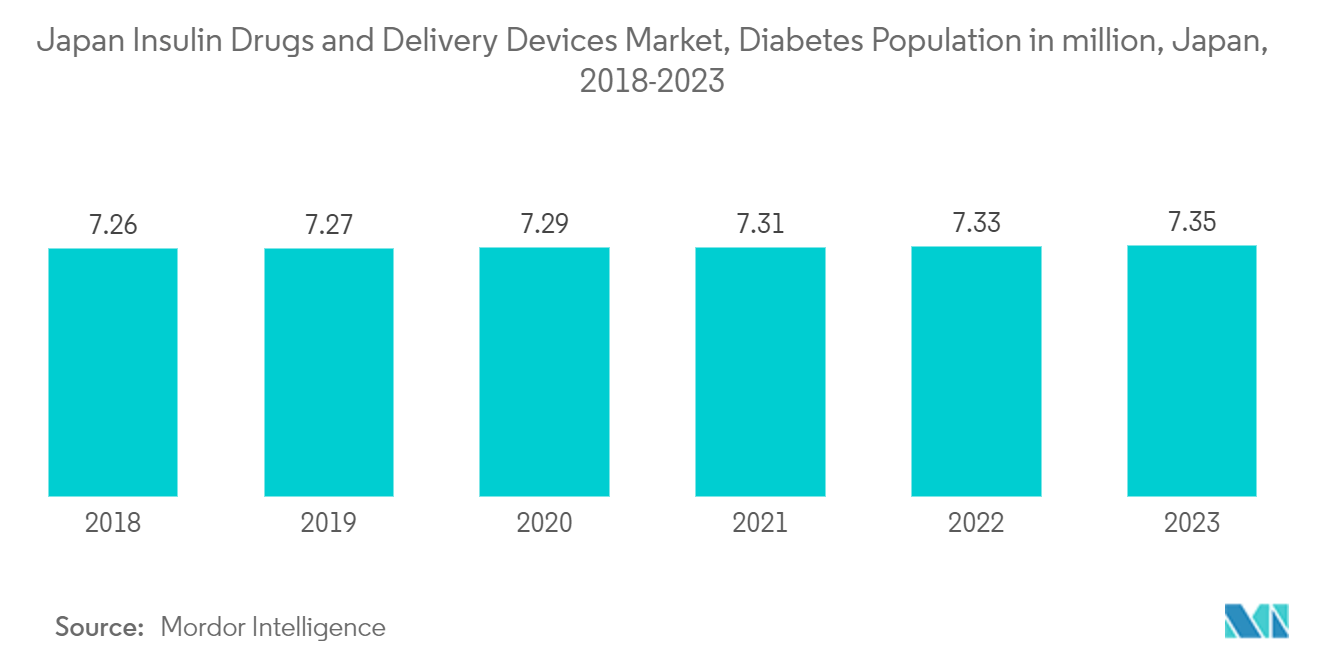
The Insulin Pumps Segment is Expected to Witness Highest Growth Rate Over the Forecast Period
Insulin is delivered subcutaneously via a cannula attached to a patch. When the pump is used independently of the AID system, a remote control can adjust administration settings such as basal and bolus.
A predictive low-glucose management (PLGM) insulin pump was introduced in Japan. The sensor automatically suspends insulin delivery when it detects or predicts low glucose levels. The number of insulin pump users among Japanese patients with type 1 diabetes mellitus is estimated to be around 10,000, implying that the insulin pump has not yet permeated Japan.
Diabetes has been identified as a healthcare priority by the Ministry of Health, Labour, and Welfare (MHLW). The high prevalence of type 2 diabetes is associated with a significant economic burden. The costs of diabetes are increased in patients with co-morbidities such as hypertension and hyperlipidemia and in patients who develop complications. Costs increase with an increasing number of complications. Well-organized medical insurance systems cover all medical fees for diabetes mellitus, and people with diabetes can visit doctors freely in Japan. Also, insulin therapy by self-injection became legal and is covered by health insurance. Such advantages have helped the adoption of these products in the Japanese market.
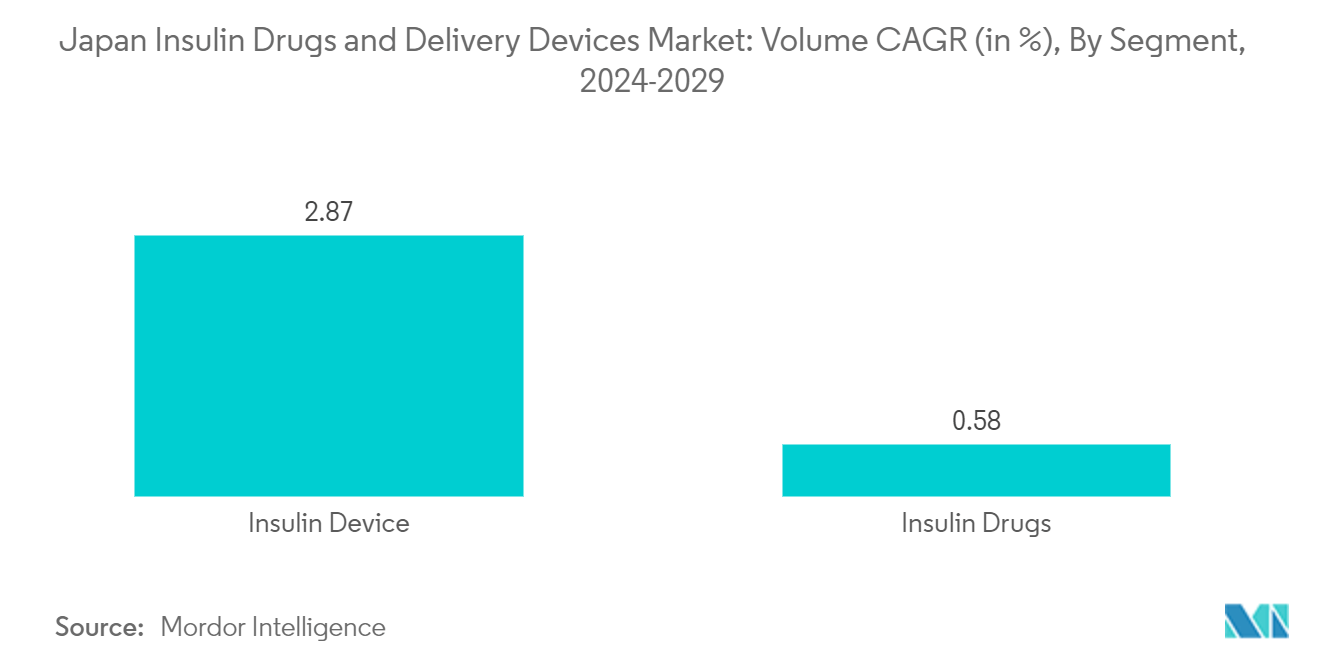
Japan Insulin Drugs And Delivery Devices Industry Overview
Japan's Insulin Drugs and Delivery Devices Market is consolidated. Mergers and acquisitions that happened between the players in the recent past have helped the companies strengthen their market presence. Eli Lilly and Boehringer Ingelheim together have an alliance in developing and commercializing Basaglar (Insulin Glargine). Additionally, the players in the recent past helped the companies strengthen their market presence; for example, Novo Nordisk collaborated with Ypsomed to provide better insulin therapy solutions.
Japan Insulin Drugs And Delivery Devices Market Leaders
-
Novo Nordisk
-
Sanofi
-
Eli Lilly
-
Medtronics
-
Roche
*Disclaimer: Major Players sorted in no particular order
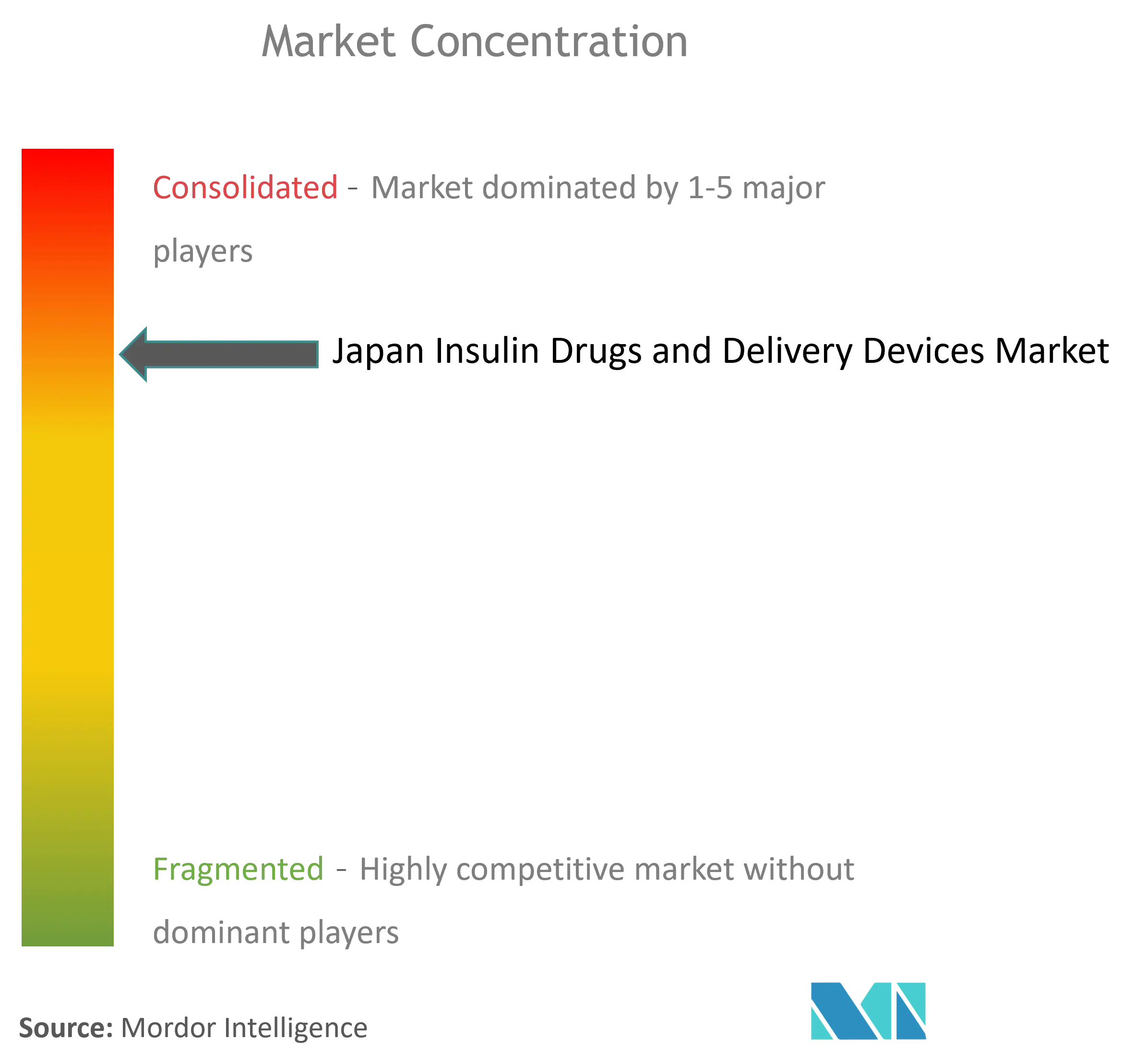
Japan Insulin Drugs And Delivery Devices Market News
- June 2022: Health2Sync and Sanofi partnered to digitize insulin management in Japan. Both companies still have plans to extend their partnership in bringing digital therapeutic solutions to patients and healthcare professionals in Japan and other markets.
- November 2021: Terumo Corporation, based in Japan, and the French company Diabeloop, have signed an agreement for a comprehensive strategic partnership. With this agreement, in addition to the current joint development of the AID system for Japan, they will work closely to bring Automated Insulin Delivery (AID) solutions to Europe with potential further global expansion.
Japan Insulin Drugs And Delivery Devices Market Report - Table of Contents
1. INTRODUCTION
- 1.1 Study Assumptions and Market Definition
- 1.2 Scope of the Study
2. RESEARCH METHODOLOGY
3. EXECUTIVE SUMMARY
4. MARKET DYNAMICS
- 4.1 Market Overview
- 4.2 Market Drivers
- 4.3 Market Restraints
-
4.4 Porter's Five Forces Analysis
- 4.4.1 Bargaining Power of Suppliers
- 4.4.2 Bargaining Power of Consumers
- 4.4.3 Threat of New Entrants
- 4.4.4 Threat of Substitute Products and Services
- 4.4.5 Intensity of Competitive Rivalry
5. MARKET SEGMENTATION
-
5.1 Drug
- 5.1.1 Basal or Long-acting Insulins
- 5.1.1.1 Lantus (Insulin Glargine)
- 5.1.1.2 Levemir (Insulin Detemir)
- 5.1.1.3 Toujeo (Insulin Glargine)
- 5.1.1.4 Tresiba (Insulin Degludec)
- 5.1.1.5 Basaglar (Insulin Glargine)
- 5.1.2 Bolus or Fast-acting Insulins
- 5.1.2.1 NovoRapid/Novolog (Insulin aspart)
- 5.1.2.2 Humalog (Insulin lispro)
- 5.1.2.3 Apidra (Insulin glulisine)
- 5.1.2.4 FIASP (Insulin aspart)
- 5.1.2.5 Admelog (Insulin lispro Sanofi)
- 5.1.3 Traditional Human Insulins
- 5.1.3.1 Novolin/Mixtard/Actrapid/Insulatard
- 5.1.3.2 Humulin
- 5.1.3.3 Insuman
- 5.1.4 Combination Insulins
- 5.1.4.1 NovoMix (Biphasic Insulin aspart)
- 5.1.4.2 Ryzodeg (Insulin degludec and Insulin aspart)
- 5.1.4.3 Xultophy (Insulin degludec and Liraglutide)
- 5.1.4.4 Soliqua/Suliqua (Insulin glargine and Lixisenatide)
- 5.1.5 Biosimilar Insulins
- 5.1.5.1 Insulin Glargine Biosimilars
- 5.1.5.2 Human Insulin Biosimilars
-
5.2 Device
- 5.2.1 Insulin Pumps
- 5.2.1.1 Insulin Pump Devices
- 5.2.1.2 Insulin Pump Reservoirs
- 5.2.1.3 Insulin Infusion sets
- 5.2.2 Insulin Pens
- 5.2.2.1 Cartridges in reusable pens
- 5.2.2.2 Disposable insulin pens
- 5.2.3 Insulin Syringes
- 5.2.4 Insulin Jet Injectors
6. MARKET INDICATORS
- 6.1 Type-1 Diabetes Population
- 6.2 Type-2 Diabetes Population
7. COMPETITIVE LANDSCAPE
-
7.1 COMPANY PROFILES
- 7.1.1 Novo Nordisk
- 7.1.2 Sanofi
- 7.1.3 Eli Lilly
- 7.1.4 Biocon
- 7.1.5 Julphar
- 7.1.6 Medtronic
- 7.1.7 Ypsomed
- 7.1.8 Becton Dickinson
- *List Not Exhaustive
- 7.2 COMPANY SHARE ANALYSIS
8. MARKET OPPORTUNITIES AND FUTURE TRENDS
** Subject To AvailablityJapan Insulin Drugs And Delivery Devices Industry Segmentation
Insulin drugs refer to medications that contain insulin hormone, which is used to manage blood sugar levels in individuals with diabetes. These drugs are primarily used in the treatment of type 1 diabetes, where the body produces little to no insulin, as well as in some cases of type 2 diabetes where insulin therapy is necessary. Insulin drugs come in various formulations, including rapid-acting, short-acting, intermediate-acting, and long-acting, each with different onset and duration of action to suit individual patient needs. Japan insulin drugs and delivery devices market is segmented into drugs, and devices. The report offers the value (in USD) and volume (in mL) for insulin drugs and (in unit) for the devices for the above segments.
| Drug | Basal or Long-acting Insulins | Lantus (Insulin Glargine) |
| Levemir (Insulin Detemir) | ||
| Toujeo (Insulin Glargine) | ||
| Tresiba (Insulin Degludec) | ||
| Basaglar (Insulin Glargine) | ||
| Drug | Bolus or Fast-acting Insulins | NovoRapid/Novolog (Insulin aspart) |
| Humalog (Insulin lispro) | ||
| Apidra (Insulin glulisine) | ||
| FIASP (Insulin aspart) | ||
| Admelog (Insulin lispro Sanofi) | ||
| Drug | Traditional Human Insulins | Novolin/Mixtard/Actrapid/Insulatard |
| Humulin | ||
| Insuman | ||
| Drug | Combination Insulins | NovoMix (Biphasic Insulin aspart) |
| Ryzodeg (Insulin degludec and Insulin aspart) | ||
| Xultophy (Insulin degludec and Liraglutide) | ||
| Soliqua/Suliqua (Insulin glargine and Lixisenatide) | ||
| Drug | Biosimilar Insulins | Insulin Glargine Biosimilars |
| Human Insulin Biosimilars | ||
| Device | Insulin Pumps | Insulin Pump Devices |
| Insulin Pump Reservoirs | ||
| Insulin Infusion sets | ||
| Device | Insulin Pens | Cartridges in reusable pens |
| Disposable insulin pens | ||
| Device | Insulin Syringes | |
| Insulin Jet Injectors |
Japan Insulin Drugs And Delivery Devices Market Research FAQs
How big is the Japan Insulin Drugs And Delivery Devices Market?
The Japan Insulin Drugs And Delivery Devices Market size is expected to reach USD 8.5 billion in 2024 and grow at a CAGR of 2.40% to reach USD 9.57 billion by 2029.
What is the current Japan Insulin Drugs And Delivery Devices Market size?
In 2024, the Japan Insulin Drugs And Delivery Devices Market size is expected to reach USD 8.5 billion.
Who are the key players in Japan Insulin Drugs And Delivery Devices Market?
Novo Nordisk, Sanofi, Eli Lilly, Medtronics and Roche are the major companies operating in the Japan Insulin Drugs And Delivery Devices Market.
What years does this Japan Insulin Drugs And Delivery Devices Market cover, and what was the market size in 2023?
In 2023, the Japan Insulin Drugs And Delivery Devices Market size was estimated at USD 8.30 billion. The report covers the Japan Insulin Drugs And Delivery Devices Market historical market size for years: 2019, 2020, 2021, 2022 and 2023. The report also forecasts the Japan Insulin Drugs And Delivery Devices Market size for years: 2024, 2025, 2026, 2027, 2028 and 2029.
Japan Insulin Drugs And Delivery Devices Industry Report
Statistics for the 2024 Japan Insulin Drugs And Delivery Devices market share, size and revenue growth rate, created by Mordor Intelligence™ Industry Reports. Japan Insulin Drugs And Delivery Devices analysis includes a market forecast outlook 2029 and historical overview. Get a sample of this industry analysis as a free report PDF download.



